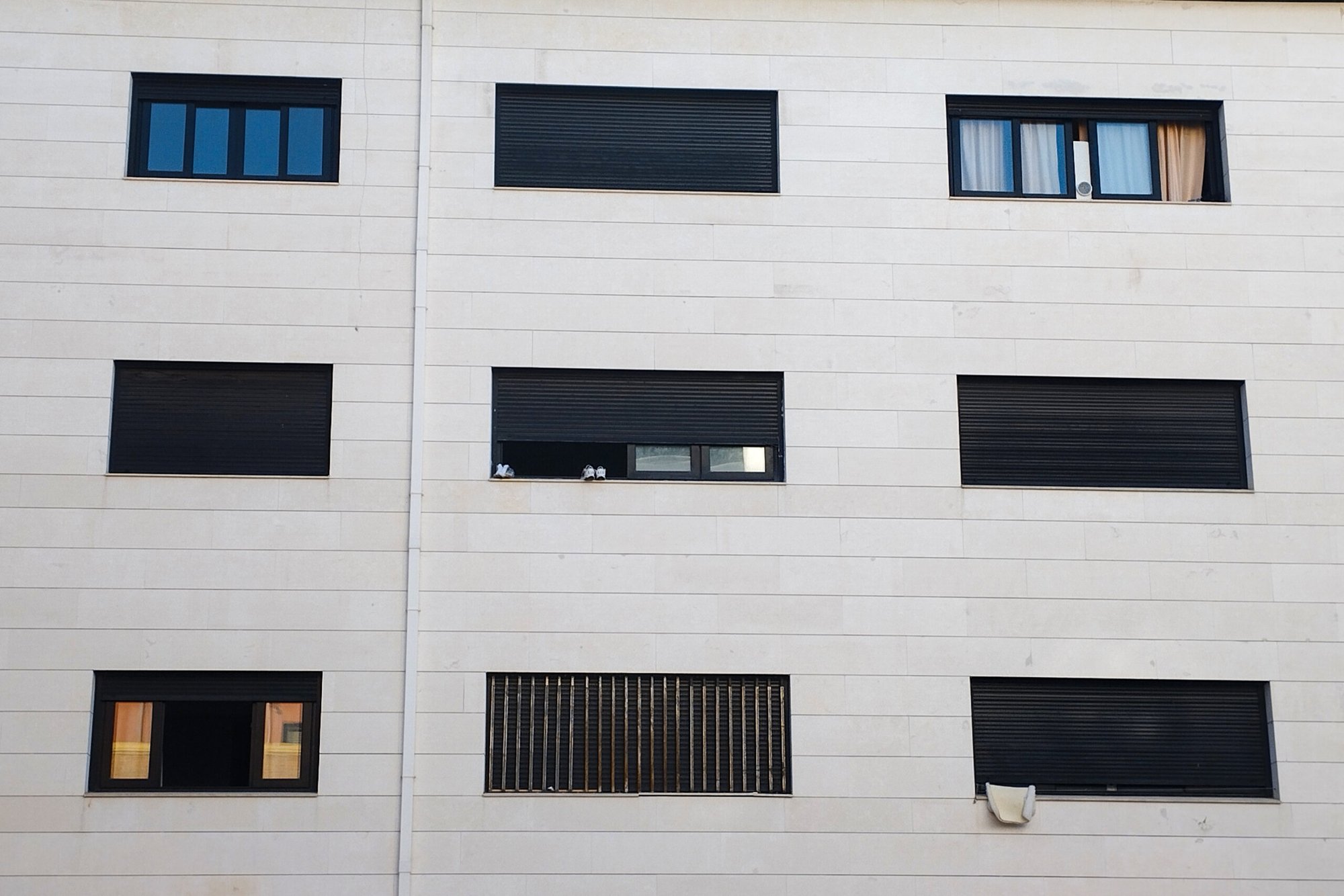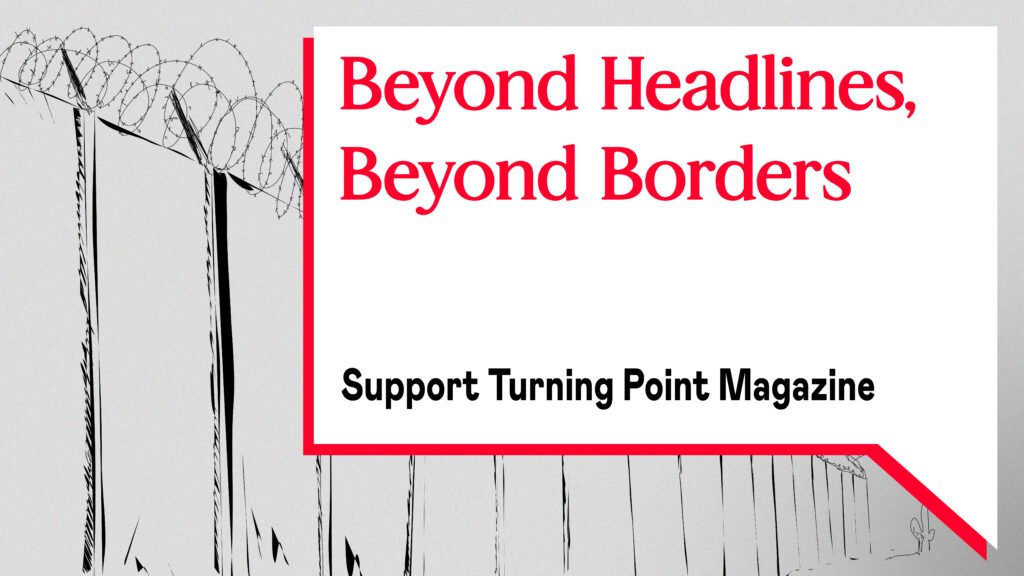Cover photo: CC Asamblea de Vivienda de Villalba
In Spain, access to housing is made complicated by sky-high prices, stagnant salaries and the increasingly severe violence of landlords who are known to: cut-off utilities, send gangs to intimidate squatters; to deceive and coerce residents. In consequence, hundreds of thousands of people, many of them with jobs, are forced to live on the street, swallow the miserable conditions or squat. In the heart of Collado Villalba, a municipality located in the northwestern mountains of Madrid, forty kilometers from the capital, more than a hundred people survive squatting without water in two blocks of public property. These buildings, known as 1315, are centers of targeted hatred and stigmatization. Organized with the Villalba Housing Assembly (AVV), this is their story and that of the block they live in.
The families of 1315 are part of the Villalba Housing Assembly, a grassroots housing collective in the Sierra de Guadarrama (Madrid) with more than seven years of experience. They are neither a public social service, an NGO, nor a subsidiary of a political party, or anything like that. AVV is a group of neighbors who united to defend the right to housing in a non-hierarchical and self-managed way. Under the fundamental principles of self-organization and mutual support, AVV is a community for struggle against the violence of the system. AVV’s activity is very diverse, ranging from: collective counselling, communication campaigns, direct action. The collective is made up of a twenty-five person hard core alongside a much larger community who collaborate on a lower level of commitment. The AVV is organized through weekly assemblies (part closed and part open), in addition to plenary meetings every three months where strategic decisions of high caliber and depth are debated and taken. Our collective is organized through a commissioning council, a permanent and defined entity with constant tasks and objectives, in addition to working groups, which have very specific objectives and are temporary. The AVV is an active part of coordination spaces with the housing movement of the Community of Madrid and other parts of the state, such as the Sareb Plan, an alliance of housing collectives for the poor and the unemployed.
In addition, we are an active part of coordination spaces with the housing movement in the Community of Madrid and other parts of the state, such as Plan Sareb, an alliance of housing collectives to collectively pressure SAREB. But what is SAREB, and why is it so important to understand the housing conflict in Spain?
Sowing bubbles, reaping violence
The construction of 1315 was abandoned in 2008, close to completion, like many homes built during the years of real estate speculation. During this time, the state abandoned its role as regulator and promoter of the housing market, liberalizing land and offering virtually unlimited credit. Housing experienced a very high revaluation, which pushed banks, construction companies and middle-class families alike to build six million homes during this time, an amount that exceeds the total number of homes built in the EU in the same period. Such a level of real estate buying and selling, appreciation and indebtedness created a bubble that burst in 2008 and added to the global economic crisis.
One of these consequences was the hundreds of thousands of properties (finished and half-built), developable land and credits that were left in limbo after the bankruptcy of their respective owners. This is what is called toxic assets. The State and the real estate employers had to find a way to return this huge amount of properties and credits to the market, and it is for this that, in 2012, the government founded SAREB (Sociedad de Gestión de Activos Procedentes de la Reestructuración Bancaria). This entity received a loan of 50 billion euros from the European Union to buy all the toxic assets and return them to the market, i.e. resell them to third parties (mostly rentiers and multi-owners, but also vulture funds and SOCIMIs (real estate companies that enjoy tax privileges) . This astronomical amount of money not only came out of the European public coffers, but the guarantor of the credit was the Spanish State. On the other hand, 55% of SAREB was owned by private banks, and 45% by the State.
For ten years (2012-2022) SAREB operated as a housing cartel. It became the largest landlord in the country, with close to 250,000 properties (built, under construction, or to be awarded). SAREB’s business model has been to buy high and sell low, operating under the interests of private real estate market players. Not surprisingly, SAREB has a reputation as one of the worst evictors in the country, resorting to a multitude of traps, dirty games and violence to evict families from homes purchased with public money. At the end of 2022, the EU executed the guarantee, forcing the State to become the majority partner of SAREB and to assume the debt of almost 29 billion euros as public debt. Since then, the government has tried to give it a progressive facelift but has not ceased its speculative and violent activity.
Meanwhile, the price of rental housing continues to rise; in Villalba the average price per m² is about 15 euros. That is to say, a 70 m² house for a family (2 parents and a child) of 70 m² would cost on average 1050 euros per month. The minimum wage is 1184 euros per month. With this we can get an idea of the critical situation of the most precarious people in Spain.
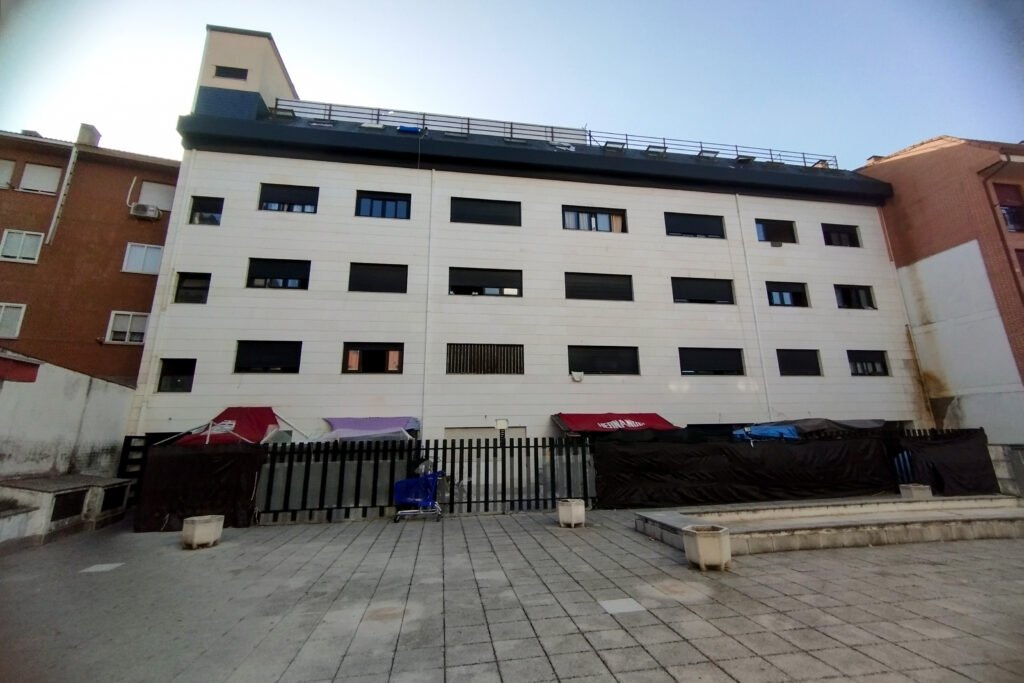
We have a right to an apartment: either it is given to us or we will take it.
In the midst of this maelstrom, in 2021, a group of people, with the support of the AVV, planned the squatting of a block of 16 houses in Calle Real, one of the main arteries of Villalba. After months of organizing, they entered and were met with an unexpected surprise that would change the course of the project. The block in question had access through a courtyard to another empty block with many more houses, 70 in particular, which added to the other 16, gave a total of 86, making it one of the largest squats in the whole of Spain.
Given the confusion and fear of a possible eviction if all the houses were not squatted, the assembly of the block itself decided to offer accommodation to more people nearby, trying to avoid a chaotic call effect. This first group was made up of punk youth from zone, older people with more experience who were in the AVV and other youth from the neighborhood. At the beginning, people who passed through the assembly and came from contacts of the motor group entered, there were also people who entered because some colleagues who worked in the social world (centers for minors, shelters, etc.) told them that they could have a house in the block. That was the first problem: more and more people did not go to the assemblies and did not respect the rules of coexistence. At the beginning, the assembly controlled the apartments that were squatted and if you wanted to put someone in your house you had to go through the assembly, a sovereign space for management. In the end, the dreaded call effect did occur, as these kids called more and more of their acquaintances, completely bypassing the assembly. These new people did not participate in it either, and little by little they lost more and more strength. When they wanted to realize it, they were living together a cloud of unknown people looking for a living in any way they could, some of them without papers, without work, and others who have been so punished and excluded by this capitalist and racist system that for years they had no other way of survival than delinquency.
As time went on, tensions increased and coexistence worsened. They began to gain ground, the politicized people burned out and the rest of the normative people began to leave because they did not see it as a safe place. In addition, power corrupted several people, who settled violent and authoritarian dynamics disguised as good intentions. In fact, the AVV was kicked out of the block for being an external entity, denying its possibility of participation and mediation.
In the beginning, 1315 did have a great deal of neighborhood support, or at least passive tolerance, and the neighborhood did not perceive them as delinquents but as people looking for a living. They deployed communication campaigns explaining the profile of the people who lived there, many families with children, elderly people, people with disabilities… but with time and the degradation of coexistence, many of these people began to leave and others who generated conflicts and did not respect the rules of coexistence entered. This is where 1315 began to lose the respect of the neighborhood. This is one of the problems with which the housing movement is very familiar: precariousness and its effects. People who have never been organized, who have always been excluded from society, who have not been given opportunities, who carry a backpack and a label on their backs that stigmatizes them in the cruelest way… it is to be expected that their only option is to survive on their own and evade reality as best they can. One of the companions interviewed, Fernando, tells us that “there was no strong assembly project to manage the space according to the needs of the people who inhabit it, they could not or did not know how to orient and support the project well. In other community projects in which I have lived, things did not work like that, in La Manuela (2014-2015, Madrid), you lived where the assembly told you to live, you moved house according to the needs of the assembly, you entered directly with that premise”. Where did it all end up?
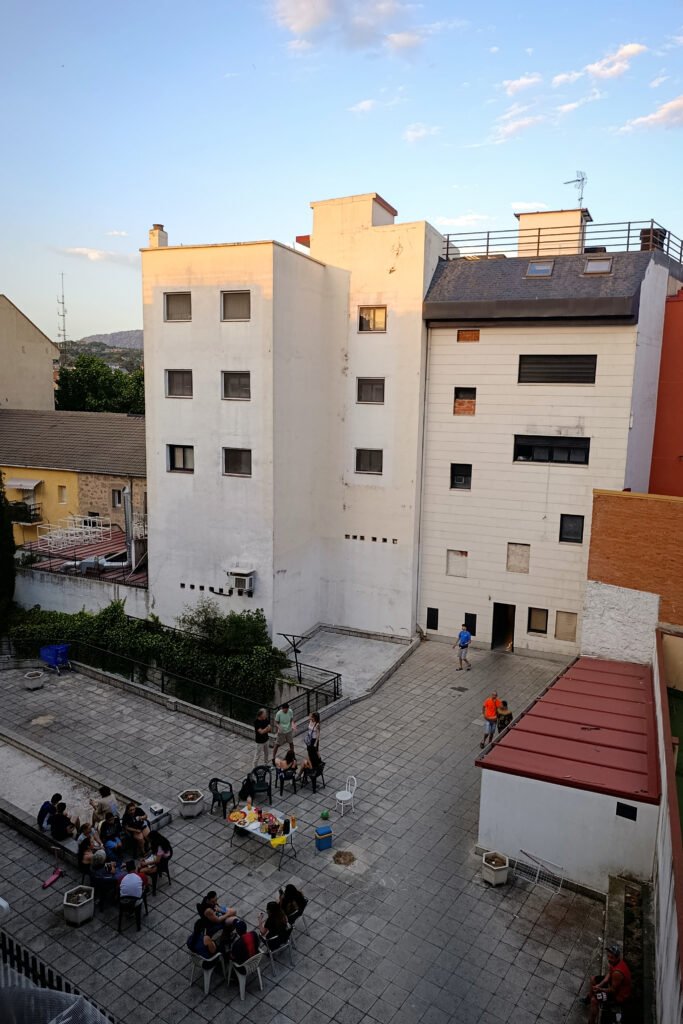
Day-to-day life in 1315 is complicated. As we have said, the profile of its inhabitants is very diverse: working families who lost their homes, people of different nationalities in an irregular situation, young people, the elderly, etc. The common denominator of all the neighbors is survival, they all survive as best they can in varying degrees of need. Some work, others deal in drugs, steal, etc. The absence of collective control and individualistic dynamics have allowed 1315 to be used by people who, after committing crimes, take refuge there, who go there to consume, or who sleep on the ground floor or in the garage for lack of a better place. According to another colleague interviewed, María, broadly speaking, “there are two types of people: those who mess up and those who don’t. There are low-profile people, or those who do not. There are low-profile people, or people who work and have children, you see them coming and going during their working hours, and if you need anything you can go and ask them. Coexistence is normal, as in any building. But then there is the rest, they generate problems, they take drugs, they get drunk and fight, there is shouting, you keep your distance from all these people and you don’t engage in conversation because you don’t know where they are going to come from. Many times the police have had to come to the scene because of these situations. Then you get a sense of insecurity that doesn’t allow you to be at ease in your own home. You don’t know what you’re going to find when you leave in the morning to go to work, or what the new problem is that has come up while I was at work.” It all boils down to a general lack of trust because most people go their own way. They’ve even put 45 locks on the door so that people from outside can’t get in, and they always end up breaking. They have even resold keys to the doorway, not to mention apartments. In the end, this has a demoralizing effect on the neighbors of the block, especially on those who always stand up for themselves: “we get tired of doing things to improve the coexistence and, what a coincidence that these are always the women! We are the ones who clean, repair and mediate when there are conflicts. Where are the men who complain so much? It would be nice if they also participated more in these tasks…” comments Maria.
It doesn’t help that the state of the houses is quite pitiful. It is an unfinished construction, of very poor quality and abandoned since 2008; 28-29 m² studio apartments with one bathroom and one room, without water and with electricity installed and hooked up. It has not been granted the cédula de habitabilidad, which is a certification that the building can be legally inhabited. There are some where the neighbors have been able to organize among themselves to buy water pumps that go to the garage, flooded by a fault in the construction of the building, and have non-drinking water at home; most do not and have to go to the fountain to refill carafes. There are also other apartments where common furniture was missing, such as faucets, floors, doors, clogged pipes… “now, in spite of all this, if you have wanted to invest in the house, the houses are fine, they are small but normal”, says María.
Their hate, our misery
Sobre las vecinas de Real 1315 ha caído una durísima campaña de estigmatización y odio hacia el pobre desde el principio y que continúa hasta nuestros días. Esta campaña ha sido orquestada desde el Ayuntamiento (en manos del Partido Popular, de línea conservadora con retórica cada vez más fascista) y medios de comunicación afines, con la permisividad completa de SAREB (y por tanto del gobierno central, llamados “progresistas”). La política del Ayuntamiento se ha basado en la criminalización de más de cien personas hasta convertirlas en la caricatura del monstruoso y violento okupa, merecedor de lo que le ocurra y cabeza de turco de infinidad de problemas, tomando por bandera la lucha contra la okupación y usándola como pantalla de humo de su nefasta gestión del municipio. Ejemplo de esto fue la apertura de la primera Oficina Antiocupación de toda España, a escasos metros del bloque y en una galería de arte cerrada a propósito, apenas seis meses después de su okupación.
From the beginning, residents of Real 1315 have been subjected to a campaign of harsh stigmatization and hatred against the poor. This campaign has been orchestrated by the City Council, (under the control of the conservative Popular Party, which has been accused of increasingly fascist rhetoric), and its affiliated media outlets, and continues to this day. The campaign has also benefitted from the permission stance of the SAREB, and therefore the nominally “progressive” central government..The City Council’s policy has been based on the criminalisation of more than 100 people, turning them into caricatures of the monstrous and violent squatter, deserving of whatever happens to them and a scapegoat for countless problems. The banner of anti-saquatting is often used as a smokescreen for terrible management of the municipality. An example of this was the opening of the first Anti-Squatting Office in all of Spain, just a few meters from the block and in a purposely closed art gallery, barely six months after its squatting.
The mayor presented the Office as a legal advice service for those affected by squatting. She does not offer data to justify its opening, nor does she accompany it with measures to solve the housing problem. The award, worth 15,000 euros, is made through a minor contract to ensure the opacity of the Office, managed by Toni Miranda, president of the National Organization of People Affected by the Squatting (ONAO). However, the AVV uncovered that the actual awardee of the contract was Salvador Palazón Marquina, owner of the gang of Desokupa Exprés SL Desokupa desokupa accused of extrajudicial evictions with extreme violence. In other words, the City Council was lying about the Office and through it was financing the activity of these thugs, while obtaining political mileage in their fight against squatting by setting themselves up as staunch defenders of private property at all costs. The AVV’s thoughtful but ambitious #DesocupaLaOficina campaign achieved its goal of forcing the City Council to terminate the contract and close the Office, which was a resounding success.
But the stigmatization campaign did not end there: “they have even sent television stations to ”make a report” on crime in 1315 and thus continue to increase social alarm. Madam, in Calle Real there has always been crime and in the station square (20 meters from the block) drugs, this is not something new. What you are doing is diverting the focus of attention from your nefarious management: unrepaired roads, unpaid workers, they have even been caught with the light punctured in the streetlights of one of the main shopping streets of the municipality. But the problem is the “squatters”. Then they are also going to bother closing fountains and sending the local police to increase tension and peeping toms in the neighborhood.” “There is also a visceral hatred for the poor, for those who break the rules, for those who rebel.… If the neighbors of 1315 do not make noise, they become invisible poor people, who one day will leave without having bothered, without having made noise to denounce all the harassment they suffer. A former neighbor was the first who was given the relocation because she has been the only one who has bothered, she has been kicked out of the town hall plenary sessions for shouting at Mariola… and she did this by making noise”. Fernando tells us. “The city council criminalizes and stigmatizes us. Of course there is delinquency in 1315! But we are not all neighbors, the rest of us are humble people who need a roof to live under without hurting anyone. Why don’t you (the mayor) come and see it with your own eyes? They profit from everything that happens to us neighbors in the block,” shares Maria.
On the other side, SAREB continues to maintain open cases to this day to people and families with whom it is sitting negotiating a social rent (rents that are more “affordable” for people in vulnerable situations, although this entity always processes them fraudulently). They even maintain the evictions by calling the court at the last minute to stop them, with all the police apparatus set up. Apart from all the psychological damage they do to women, men, the elderly and children, which is already a disgrace, they use a lot of public resources to extort people with a social rent with the threat that if they do not sign it they will be thrown out on the street. If we were to explain in detail the multiple bad practices of SAREB, we would occupy the entire space of this article.
Digging further into the neighborhood perception of the 1315, we must emphasize first of all that in Villalba most of the commercial premises are in the hands of a few families of caciques, with a good handful of other subaltern families that reproduce the same capitalist discourse. They have stirred up the hornet’s nest to benefit themselves, promoting a hateful, racist and aporophobic discourse that is deeply permeating society, with the growing criminalization of poverty and squatting that has the full support of the mass media and the approval of those in power. The biggest problem of 1315 is the social alarm that has been created, on the one hand true, since one cannot deny all the conflict that comes out of the block, but unfounded on the other hand, because the just pay for the sinners. An example of this were the comments on social networks after the arson of 2022, which we will talk about next and which put more than a hundred people in danger of death. Some neighbors commented that it was a pity that no one had been burned, or that we would have to try again to “clean” Villalba of the “damn squatters”.
Fernando tells us that “there are people who have known me all my life and used to greet me, who now change their faces when I pass by them. They have withdrawn their greetings and give me a bad face”. Another of the interviewed companions, Elena, shares her experience and analysis of the situation on this issue: “they treat us terribly for obvious reasons, there are many fights in the street, the dirt that is generated from these fights (blood, glass, garbage). When people pass in front of the door of the block and there are kids, they don’t say good morning to you politely, they look you up and down to see what you can carry, and if you are 60 years old and walking your dog Manchitas, they intimidate you. There is also the issue of theft, we have been robbed several times in the bakery next door, where everyone goes for breakfast, they let you go to the bathroom without consuming, to clean up, to get water, etc.. They themselves are digging our own grave.”
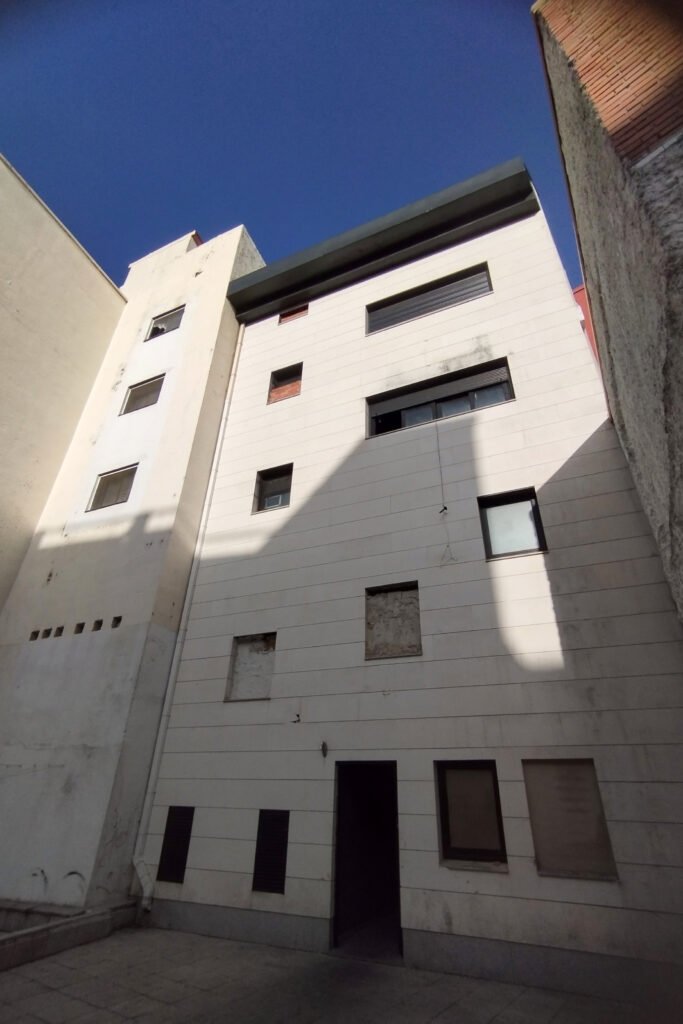
Chronicle of a fire foretold
In the early morning hours of December 28, 2022, an arson fire broke out in several outbreaks. It was the neighbors who raised the alarm about the smoke and flames. The prompt and professional intervention of the firefighters of Park 42, whom we thank again for their action, prevented deaths. Several neighbors were hospitalized: most for smoke inhalation and burns, another broke her hand in two while carrying her children down the stairs to get them out of their burning home. The small block of 16 houses was the worst affected. Firefighters closed the access due to the presence of toxic substances, confirming that structurally the building had not been affected and that only a thorough cleaning was required so that the neighbors could return to their homes.
From AVV we mobilize the neighborhood support networks to welcome and support the psychological and material needs of all those affected. In a tragedy like this, any help is too little. The City Council has not mobilized any of its resources. Social Services was totally absent in assisting all the people affected and SAREB used the fire to illegally evict the 16 families living in the most affected block, leaving the neighbors homeless and without their belongings, since they gave almost no time to recover things. All this with the “kind collaboration” of the Civil Guard. The icing on the cake came on January 4, when the City Council cut the public fountains with the excuse of frost (the closest one had already been closed years ago, without ever wanting to explain why). The residents of 1315, who have no running water, depend on the public fountains for water for drinking, cooking, cleaning and washing. The Town Hall knows this, and cutting off the public fountains a week after the fire was yet another aggression to these neighbors, and to the whole town in general, as the public fountains provide multiple services. The next day, January 5, the AVV organized “El Garrafón”, a water collection with the double objective of collecting water for the neighbors and pressuring to reopen the fountains. In fact, a few days later they were reopened.
Elena tells us her own experience of how they lived through this unprecedented tragedy: “At 07:00 I was knocked at the door, it was full of smoke and they told me that we had to leave because the building was on fire. I went to knock on the other doors and nobody answered. So we had to leave. The main fear we had was that the fire in the small block would pass to ours and that we would not be able to get out because our entrance is boarded up. Once outside we saw that everyone was in the bakery next door and the firemen were trying to get in to rescue people who were still inside. One family was locked in their house and their door was starting to burn, other kids tried to escape to the roof and stayed there, and another family with two children could not get out because they could not operate the doorknob because it was so hot. Firefighters tried to put out the fire on the door, but could not. They then had to carry the ladder to get the children out of the window. It was a tense moment as the fire was entering the house. I have the image of Yussef hanging there with his son looking down. His panicked expression said “I can’t get in again, I can’t let go because it was too high and I don’t know if the crane will arrive before the fire enters the house” until, finally, the crane arrived and the firemen were able to rescue them. Another neighbor burned both his hands when he grabbed the staircase railing and ran away, when nothing was visible inside the building. Despite the traumatic moment, I felt the solidarity of the neighbors of the neighborhood, bringing us blankets, water, food, etc., as well as the neighbors of the block. It took us two days to relocate the 20 people to our houses in the other block that had not burned down. I remember that moment when we started to organize it, all the neighbors’ things were in the middle of the courtyard and we were in a circle seeing where everyone was going. At the end of the day, it is once again demonstrated that it is the neighbors themselves who are there when problems occur. As expected, the City Council did not offer anything, nor did SAREB. If it weren’t for the neighbors these people would be out on the street.”
The message conveyed by the City Council with its action in the face of this tragedy was that there are first and second class villalbinas. On the day of the fire and before the media, a neighbor said that “if it had been in the block across the street, [the mayor] would already be taking pictures with the ladies of the neighborhood”. In other words, that there are “burnable and disposable” people, “because nothing happens here”, “stigmatization is what gets us burned alive”.
“Once it was out,” Elena continues, “the firemen let the neighbors take out the four basic things. The second day the Guardia Civil came saying that we had 15 minutes per house to get things out and then we would have more time to get them out. At that point I came to believe it and everything, they came politely telling us that we would have more time later, but it was a lie. Once everyone was out, SAREB came and walled up the building. It was the only time I have ever collapsed because of something related to the block. I had to look at the Guardia Civil and tell them that they had lied to us. You are walling it up with our things inside! It was inhumane, there were people who could only take out their wheelchairs and four other things. There were people who couldn’t get their things out because they were hospitalized for smoke intoxication. I don’t understand it, the property came with an expert to assess the state of the building and, to this day, it is still closed, they have not cleaned it and all our things are in there. And to top it off, a few days later the Guardia Civil comes again with SAREB to install alarms. First they burn us alive and then they illegally evict us. Here we see all the repression of the state, the public institutions and the state security forces and bodies.”
“After this, the assemblies came back, people were afraid again and saw the need to organize. Things that could be incendiary were collected from the corridors, cleaning brigades were formed, fire extinguishers were obtained, etc., but as time went by the fear dissipated and chaos reigned again.”
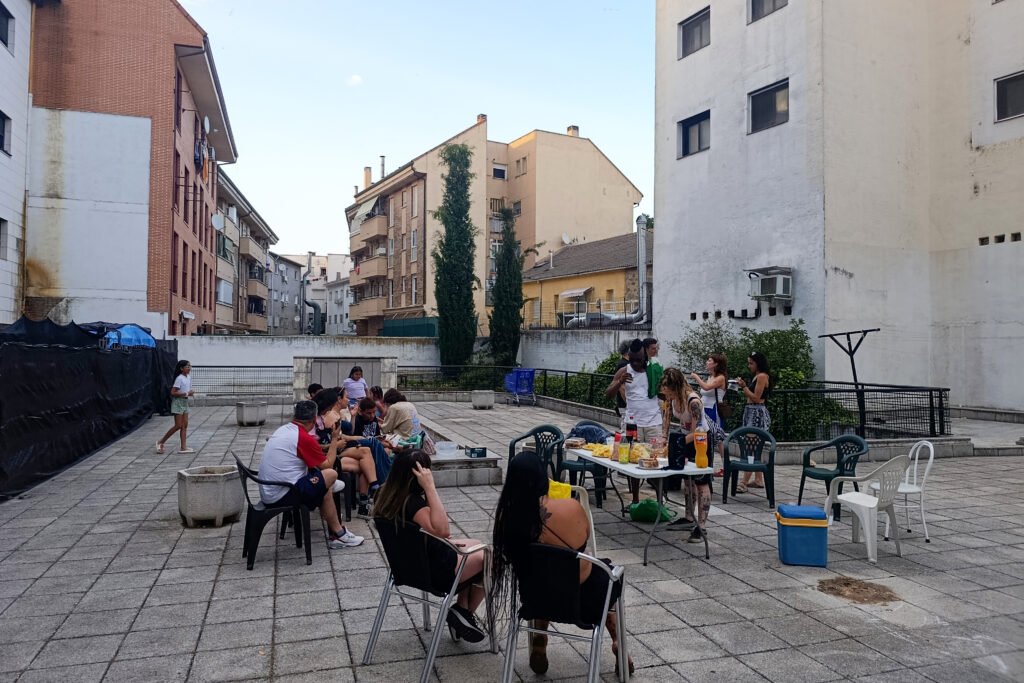
The return of hope
In spite of everything the neighbors say about living together and the social stigma they carry behind them, there is a glimmer of light that has given them back some hope: organization. They share with us that, lately, things are different. Since January 2025, when the AVV gave new impetus to the assemblies and succeeded in getting SAREB to collectively negotiate the social rents of the neighbors, the collective dynamics of responsibility and care have been gaining ground over the destructive ones. The block assemblies are weekly, with increasing participation. The neighbors are becoming empowered, they help each other to get the necessary papers for the bureaucracy that this entails, they help each other so that everyone who does not understand Spanish knows what they have to do, and for whatever is needed. They have organized themselves to pick up the garbage, clean the garages, paint the halls and keep them clean. Fear has not left the neighbors, and rumors run fast due to many insecurities; but the sharing of this has been a tool of union and empowerment.
María shares this reflection on this whole process: “And if I have to leave my home to come to Madrid to fuck around, I’m going to Madrid to fuck around. Because I’m still from 1315, because for me 1315 is not the building, it’s my neighbors. Because 1315 is only four walls, but from 1315 I take people with me, people who do not deserve to be in that situation, who deserve someone to help them and who deserve someone to fight for them, because many of them cannot. So I’m not going to stop fighting for my part.”
Elena reaffirms hope: “What has changed is that we people who were burned have regained hope. We are holding assemblies again and people are coming. Before, we didn’t even have the strength to propose them. It has given us hope again and, I think it happens to several people, the AVV is the reason why we have not left. It helps us that people from outside come because they do not live all the internal movements and so they do not get burned so much. This makes us want to keep fighting and not give up, it is a support. I see it as a second stage in which we can do things better, or at least try to. If I had to qualify how the atmosphere and coexistence in 1315 has changed since the AVV started organizing the block it would be hopeful.”
SAREB is ours, their homes too.
